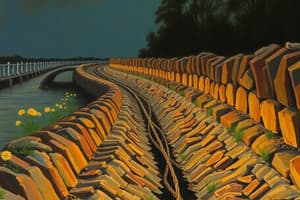Podcast
Questions and Answers
What type of cable is not suitable for underground laying?
What type of cable is not suitable for underground laying?
- Jelly filled armoured cables
- Cables with paper insulation (correct)
- Polythene insulated copper quads
- Cables with PIJF insulation
What is the recommended size of conductor for subscriber's connections up to 5 km in outdoor underground laying?
What is the recommended size of conductor for subscriber's connections up to 5 km in outdoor underground laying?
- 2.81 mm
- 1.83 mm
- 0.5 mm (correct)
- 0.63 mm
What is the purpose of specifying the size of the telephone exchange cables?
What is the purpose of specifying the size of the telephone exchange cables?
- To indicate the type of sheath
- To indicate the number of pairs and dia of conductor (correct)
- To indicate the type of armouring
- To indicate the type of insulation
What type of insulation is recommended for local subscriber's connection in a building?
What type of insulation is recommended for local subscriber's connection in a building?
What is the recommended type of cable for underground laying?
What is the recommended type of cable for underground laying?
What is the weight of a 0.5 mm cond Dia twisted Pair PIJF cable?
What is the weight of a 0.5 mm cond Dia twisted Pair PIJF cable?
What is the recommended size of conductor for trunk connections?
What is the recommended size of conductor for trunk connections?
What type of cable is recommended for exchange to MDF wiring?
What type of cable is recommended for exchange to MDF wiring?
Why should RE cable containing paper as well as polythene insulated copper quads be replaced?
Why should RE cable containing paper as well as polythene insulated copper quads be replaced?
What is the recommended type of cable for subscriber's connections up to 10 km?
What is the recommended type of cable for subscriber's connections up to 10 km?
Flashcards are hidden until you start studying
Study Notes
Cable Laying and Jointing
- HDD (Horizontal Directional Drilling) method should be used to lay cables in DWC pipes or approved protection arrangements in busy areas, especially at road-crossings or rail-crossings.
- Concrete large size ducts provided in station sections for signalling cables can be utilized for telecom cables, following due precautions.
Cable Termination
- Cables can be terminated in DP Box of approved type or through direct termination.
- PIJF cables of various sizes shall be terminated through DP Box of approved type.
Jointing of PIJF Cable
- Jointing should be done by a skilled and experienced person using the correct RDSO specified jointing kit to ensure quality.
- Jointing should be done under close supervision of telecom staff, and video recording may be used to ensure quality.
- Thermo shrinkable jointing material shall be used for jointing armoured PIJF cable with thermo shrinkable jointing technique using RDSO's code of practice.
- Different jointing kits are available for different sizes of cables (e.g. TSF-1, TSF-2, etc.).
Testing Cable Before Laying
- Before laying, cables should be tested for insulation and continuity of the cores.
- Continuity of armour and screen of the cable should be checked before laying.
- Bedding and armouring of the cable should be inspected to ensure no damage during transit or storage.
Laying Out the Cable
- Cable drums should be mounted on cable-wheels or axles for laying out cables.
- The cable should be guided carefully into the trench by a party of labourers to avoid damage or bending.
General
- While excavating earth for trenches or making pits, the Permanent Way Inspector or representative should be present.
- In 'Quad' type cables, conductors diagonally opposite should form one circuit.
- In telephone cables, electro-static and electro-magnetic induction between different pairs of conductors should be minimized.
- RE cables containing paper and polythene insulated copper quads should be replaced at the earliest.
Sizes of Cables
- Different sizes of cables are specified for various telecommunication circuits, including outdoor underground and indoor cables.
- Sizes of cables are specified based on the circuit for use, conductor diameter, and weight per kilometer.
Studying That Suits You
Use AI to generate personalized quizzes and flashcards to suit your learning preferences.




